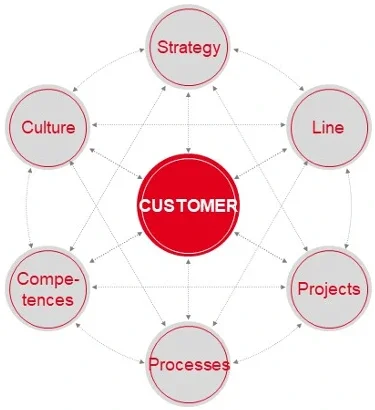No matter how we twist and turn it, we live in a VUCA* world. Shorter product lifecycles, new technologies, changing legal frameworks, digitization, changing values, and, last but not least, the pandemic lead to more challenges to companies than ever before. To ensure competitiveness, new or changed strategies, and business models are required and, ultimately, organizational changes. A process that can be understood as a transformation of the organization into a target state recommended to be carried out agile.
In this context, we speak of agile organizational development regarding a goal-oriented, long-term, and continuous process. Besides the process component, the central aspect is the organization itself, i.e., understanding and analyzing its identity as a complex system, which can be achieved in a structured way by looking at its subsystems.
The PMCC Organizational Model
The PMCC organizational model's basic idea is to understand an organization by focusing on its individual objects of consideration. On the one hand, this enables a systematic analysis of the current situation by pointing out strengths and weaknesses, and on the other hand, defining a target state of the organization in terms of an objective. The main focus is on the customer who thus is of the utmost importance. Based on expectations, the customer defines the standards by which the organization ultimately is to be aligned. In the following, these individual objects of consideration of an organization are described in more detail.
Strategy
Every organization needs a specific strategy that deals with the analysis, planning, and implementation of substantive goals. The organization’s competitiveness needs to be secured by working out or cyclical consideration of vision, business model, positioning, and strategic goals. It is also necessary to react accordingly to changing conditions. In simple terms, this is not about working for the company, but on the company.
Line Organization
A company's strategy also forms the context for the design of the organizational structure, often referred to as line organization. "Structure follows strategy" (A.D. Chandler), thus means designing an appropriate structure as well as a distribution of tasks within the company by means of an organization chart, corresponding job descriptions, and communication structures. Even if unique structures such as matrix structures, functional structures, network structures, agile structures, or hybrid variants are hyped again and again, it must be noted that there is no sole correct organizational structure, but only suitable or feasible forms corresponding to the context.
Projects
Projects are temporary organizations and are used to handle complex internal and external tasks. The ability to handle projects professionally increases the competitiveness of any organization and enables the implementation of the defined strategy. Accordingly, adequate structures, processes, and roles must be implemented. The design of project management ultimately always depends on the specific context and project types. Hence, the corresponding procedures and standards can be classic, agile, or hybrid.
Processes
Aligning processes with the organization's strategy and adapting them flexibly to changing conditions is essential, especially in times like these. Processes describe tasks that are recurring and complex and usually occur through the interaction of several organizational units. A process comprises a set of logically linked single activities carried out by the participants according to specific requirements to achieve a defined goal and meet customer expectations. In terms of continuous improvement, processes are the responsibility of a process organization, although it should be noted that process stability is the basis for agility and digitization.
Competencies
Empowering people to develop their competencies according to their roles is a central issue in every organization. Particularly in case of organizational changes, the question of imparting the necessary abilities or skills automatically arises, which means that organizational development always runs hand in hand with personnel development. Developing or learning competencies is done not only by classical education and training but also by coaching or learning "on the job."
Culture
Geert Hofstede defines culture as "the collective programming of the mind which distinguishes the members of one group or category of people from another." Thus, culture is a phenomenon that we share at least partly with other people, e.g., within the same organization or have learned it there. Culture is often neglected to the detriment of structure which is a significant risk, especially, when changing organizations. The development of an organization towards agility, for example, is not purely a question of agile methods or techniques, but rather a question of culture and "mindset."
Do you want to learn more about this topic? The second part of the blog series will follow soon, dealing with agile transformation, its four steps, and principles.
(VUCA is an acronym for volatility, uncertainty, complexity and ambiguity)







 Jira
Jira
 Confluence
Confluence
 SAP
SAP
 API
API




